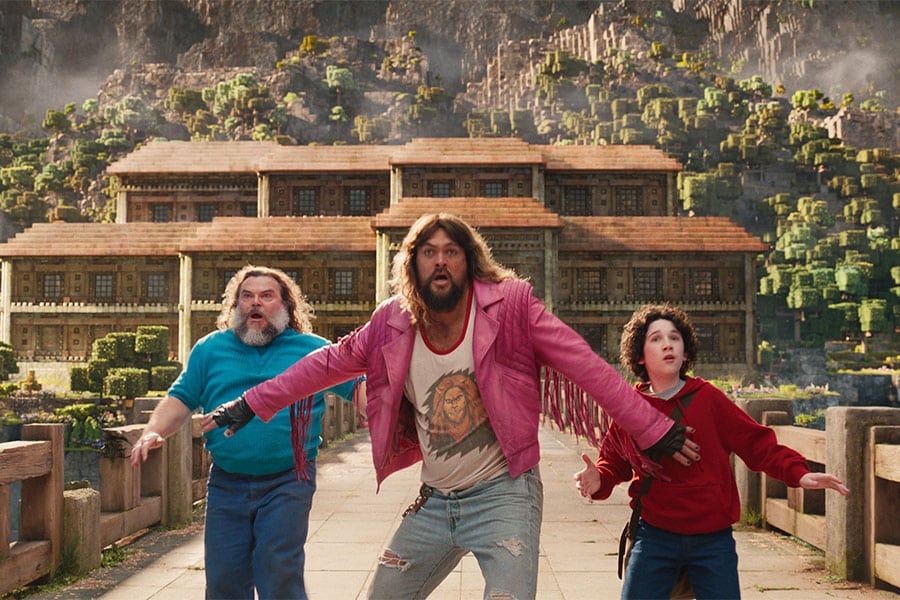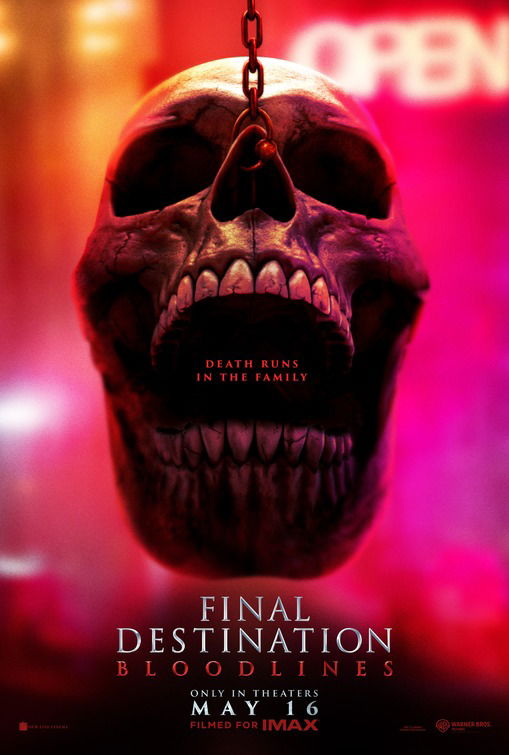Movie Reviews
Movie Review: 'A Minecraft Movie' – Catholic Review

NEW YORK (OSV News) – Motion pictures based on popular video games may have found their perfected form in “A Minecraft Movie” (Warner Bros.).
The film is unrelentingly upbeat and undistracted by manufactured sentiment. Its positive mood is struck and sustained, moreover, without resort to the cheap jokes or occasional vulgarity that often plague such adaptations.
Rather than follow the easy path of anthropomorphizing video characters, the filmmakers instead take a group of people who are frustrated with the paths of their lives in the real world and insert them into a kinetic 3D immersive version of the Swedish game’s landscape where they learn to achieve their goals.
Since their source material is the best-selling video game of all time, the quintet of screenwriters — Chris Bowman, Hubbel Palmer, Neil Widener, Gavin James and Chris Galletta — assume the pool of veteran players-turned-moviegoers is large enough for them to get away with the occasional in-joke. But even newcomers can savor the nuances on offer here.
Director Jared Hess’ production is not the type of picture from which viewers expect to take away an especially meaningful message. But it does carry with it an implied theme about better living through gameplay — in other words, you’re not just killing time, you’re building your life.
In the game, protagonist Steve, one of only two playable human characters, has a dark backstory about being the lone survivor of a worldwide virus. There’s none of that here.
On the contrary, Jack Black gives us a perpetually optimistic — albeit initially dissatisfied — version of the character. His Steve longs to escape the drudgery of being a doorknob salesman and become a miner instead.
Steve gets his opportunity when he comes across the glowing blue cube known within the game as the Orb of Dominance and finds that it opens a portal to a utopian place called The Overworld. Here, players construct their own mini-environments. They also interact with blocky people and animals.
Among the latter are creatures called piglins. The inhabitants of an evil empire known as the Nether, piglins are on a greedy quest for gold.
Steve is eventually joined by a group of other visitors to the Overwrold who are just as happy as he is to leave their unfulfilling pasts behind them. Garrett (Jason Momoa), an arcade video-game champ from decades ago, has fallen on hard times. Failed real estate agent Dawn (Danielle Brooks) wants to be a zookeeper.
For their part, youthful siblings Henry (Sebastian Hansen) and Natalie (Emma Myers) share a belief that their lives have taken a wrong turn. Additionally, Henry finds himself mocked at school for his creative impulses.
There’s no fear of that in this dimension. Having characterized the Overworld as “the biggest sandbox in the universe,” Steve observes, “Creativity in this world is the key to survival.”
Ultimately, of course, the ensemble of characters must head for home, and their return journey is, unsurprisingly, reminiscent of “The Wizard of Oz.” As in that classic, the cast learn lessons along the way and discover talents they didn’t previously know they had.
The film contains intense action sequences and some scenes of cartoonish violence. The OSV News classification is A-II – adults and adolescents. The Motion Picture Association rating is PG — parental guidance suggested. Some material may be inappropriate for children.
Read More Movie & TV Reviews
Copyright © 2025 OSV News

Movie Reviews
‘Nouvelle Vague’ Review: Richard Linklater’s Movie About the Making of Godard’s ‘Breathless’ Is an Enchanting Ode to the Rapture of Cinema

In “Nouvelle Vague,” Richard Linklater’s ingenious and enchanting docudrama about the making of “Breathless,” the 29-year-old Jean-Luc Godard (Guillaume Marbeck) never takes off his sunglasses. He wears them on the set and in the office, in restaurants and at the movies. (The film doesn’t have a bedroom scene, but if it did he might wear them there too.)
The omnipresent round dark shades serve several functions. First and foremost, they’re authentic — Godard, in the late ’50s and early ’60s, really did wear his sunglasses all the time, almost as a form of branding. They were instrumental in lending him his mystique: that of an intellectual artist who was cool, who knew how to keep his distance, who had things on his mind he was too hip to share. Yet the sunglasses also accomplish something else. In a biopic, no actor looks exactly like the person they’re playing. But the unknown French actor Guillaume Marbeck, with a bushy widow’s peak and a chiseled poker face, looks astoundingly like Godard, and without the eyes to give him away the resemblance is all but perfect. I was also amazed at how much Marbeck nails Godard’s voice — pensive and nasal in a musical way, with a hint of a reedy tremor in it.
Watching “Nouvelle Vague,” we don’t have to squint a bit to pretend that this is Jean-Luc Godard. It seems, rather, that Godard has sprung to life before us. And that uncanny quality extends to the entire movie, which plunks us down in Paris in 1959, in many of the same streets and boulevards and cafés and hotel rooms where “Breathless” was shot. The movie is in French with subtitles, and it uses lustrous high-contrast black-and-white cinematography (by David Chambille) to mirror the look of “Breathless,” and to make us feel like we’re right there, mingling with Godard and Truffaut and Chabrol and Jean-Paul Belmondo and Jean Seberg and Jean-Pierre Melville, as if we’d dropped in by time machine.
The first half hour of “Nouvelle Vague” introduces us to Godard and his colleagues on the French new wave scene, and it shows him maneuvering to direct his first movie, a privilege he thinks is long overdue, since he and his fellow critics at Cahiers du Cinéma have all vowed to become filmmakers. The owlish Chabrol has already made two features, and the debonair Truffaut has finished “The 400 Blows”; Godard, a thief when he needs to be, lifts money out of the Cahiers till to go to the Cannes Film Festival for “The 400 Blows” premiere. The film is received ecstatically, as everyone realizes they’re seeing the next generation of French cinema.
Now it’s Godard’s turn, if he can strike a deal with the producer Georges de Beauregard (Bruno Freyfürst). Godard does so by agreeing to make a gangster-and-a-girl movie based on a treatment by Truffaut, and by saying he’ll shoot it in 20 days. He recruits his young movie-actor acquaintance, the twisty-lipped hunk Jean-Paul Belmondo (Aubry Dullin), to play a small-time hoodlum antihero, and he approaches Jean Seberg (Zoey Deutch), an American movie star coming off the unhappy experience of working with Otto Preminger in “Bonjour Tristesse,” to play the American girl who gets involved with him. As far as the crew goes, it’s pretty simple: He recruits the tall and personable Raoul Coutard (Matthieu Penchinat) to be his cameraman, since Coutard shot documentary footage of the French Indochina War and Godard wants “Breathless” to look and feel like a documentary.
Godard has chosen to make “Breathless” in a particular way, and part of his slyness is that he’s going to do it without saying it out loud. Yes, the movie has locations and costumes, and yes, there’s a “script.” But Godard is seized by an insurrectionary idea: He’s basically going to make up “Breathless” as he goes along.
Once “Nouvelle Vague” arrives at the shooting of “Breathless,” the rest of the film is devoted to what happened during the shoot. And the reason this is elating to watch — in the way that a movie about the making of almost any other movie might not be — is that there’s barely any separation between the film Godard is making and what’s happening off camera.
“Nouvelle Vague” isn’t a comedy, yet there’s a deadpan comic dimension to it, and it has to do with what an insanely minimal process the making of “Breathless” was, and what it actually took for Godard to get away with that. On the first day of shooting, the first time he says “Action,” we think something is missing, because all we see is a casual handful of people standing on the street, with a small camera set up opposite a phone booth. There’s no lighting equipment (because the film is going to be made with natural light), and no sound (because it’s all going to be post-synced). I’ve seen students making a short for their college film class that looked like a bigger production than this.
Godard’s method is all about the inspiration of the moment, which means that he’ll do something like shoot for two hours and then take the rest of the day off. Each morning, at the Dupont Montparnasse, he scribbles down some version of what the actors are going to say that day, and feeds them the lines as they go along. It may sound like he’s inventing low-budget independent film. But here’s the reason he’s not.
In 1957, two years before Godard made “Breathless” (the movie premiered in January 1960), John Cassavetes shot his own first film, “Shadows,” which essentially did invent independent filmmaking as we know it. He did some of the same things Godard did. But “Shadows” was a work that broke completely with Hollywood. The glory of “Breathless” is that it’s a loose, semi-improvisatory extended bebop jazz solo of a movie, but it’s also rooted in the metaphysics of Hollywood: in movie stardom, in the tropes of gangsters and femme fatales, in the majesty of Bogart. Godard, in his genius literary screw-loose way, was making the stripped-to-the-sidewalls version of an old-fashioned movie, and that’s why the shooting of “Breathless” was, among other things, a fantastic balancing act.
He had to feed the ego of his stars, he had to convince Seberg — just about every day — that what she doing was not career suicide, and he had to convince his producer that what he was making was a real movie. Part of the charm of Godard in “Nouvelle Vague” is seeing what an ace schmoozer he is. He’ll do whatever it takes: jump rope with Belmondo, do a walking handstand. But his calling card is that he always needs to be the smartest person in the room, and he does it with such caustic wit that he has a way of leaving everyone around him in a pleasurable daze. (They don’t know what hit them.)
He keeps having encounters with famous older directors, and that’s the one place where he’s deferential, because he seems to be friends with all of them: Roberto Rossellini (Laurent Mothe), who comes to the Cahiers du Cinema offices; Jean-Pierre Melville (Tom Novembre), who Godard recruits for a cameo in “Breathless”; or Robert Bresson (Aurélien Lorgnier), who he runs into when Bresson is shooting “Pickpocket” in the subway. These filmmakers give him tips, sharing their secrets, but what connects the advice is that they’re really inviting Godard into their private club of karmic explorers. They understand that the hidden nature of filmmaking is that it’s too big, too unwieldy, too unpredictable for a director to fully control the process. All he can do is guide it.
I think it’s that perception that makes “Nouvelle Vague” such a personal film for Linklater, and his most exquisite achievement since “Boyhood.” It’s clear how deeply he identifies with Jean-Luc Godard, who comes off here as a puckish and sly dictator. He speaks in epigrams (“You should never adapt a book to the cinema, you should adapt the cinema to a book,” “A filmmaker is either a plagiarist or a revolutionary”), and he does perverse things like insist that a cup stay in the shot even if it breaks continuity. At times, he and Coutard seem to be creating the very first motion picture — mounting the camera on a car for a makeshift tracking shot, or placing it inside a cart that Coutard crams himself into, so that it’s invisible and they can use the Paris pedestrians as unpaid extras. The ingenuity of “Breathless” was miraculous, and Linklater mirrors that ingenuity in the spontaneous bravura with which he re-creates it.
But “Nouvelle Vague” also has a great theme. There’s a driving concept behind Godard’s technique, and in many ways he’s open about it: toss off the dialogue, never do more than one or two takes, shoot when you feel like it and not just to meet the schedule, find the visual poetry in real locations. But what he’s keeping inside that wry egghead of his is the secret that will hold all of this together — that if it works, he’s going to capture the lightning of reality in a bottle, and that will revolutionize what cinema can be. Even the jump-cut that came to define “Breathless” happens for a logistical reason. They have far too much footage, so Godard tells his editors: Don’t cut any scenes — just cut each scene down to its highlights. (Spoken by someone who’s either a postmodern cinema visionary or an early case of ADHD, or both.)
Just about all the actors in “Nouvelle Vague” are lusciously right for their roles. Aubry Dullin makes Belmondo a sweet-souled rogue, and Zoey Deutch’s Seberg is a force. Linklater introduces each character by flashing his or her name on screen (there’s a lot of late-‘50s Paris cinema inside baseball), and though you wish you saw more of some of them (like Agnès Varda), it’s a savory pleasure to be able to step into this time machine and luxuriate in the company of people who thought that movies were the only thing that mattered. “Nouvelle Vague” is a Linklater gem, and arriving now it really is the right movie at the right time. In an age when blockbuster overkill is supposed to be saving movies, it reminds you that the real salvation of cinema will always come from those who understand that making a movie should be a magic trick good enough to fool the magician himself into believing it.
Movie Reviews
FINAL DESTINATION: BLOODLINES Review

Despite its pro-family sentiments, FINAL DESTINATION: BLOODLINES has extremely gruesome violence and contains lots of strong foul language. Also, the story personifies Death, and he seems more powerful than God. In addition, Death shows no mercy whatsoever in FINAL DESTINATION: BLOODLINES. So, the movie has a strong, abhorrent pagan worldview that’s very superstitious.
Dominant Worldview and Other Worldview Content/Elements:
Very strong, slightly mixed, pagan, superstitious, unbiblical, and false worldview/theology/philosophy that personifies Death or the Angel of Death, making him more powerful than God, characters repeatedly say that if people mess with Death they will make him more angry, and he’ll fight back even harder to kill you in gruesome and horrifying and bloody ways, there is no mercy in this depiction of Death, plus two women have occult premonitions of terrible fatal accidents but try to stop them from happening, family decides to stick together and thwart Death’s intentions to kill them all, but they fail (also, they never appeal to God or Jesus in the movie for any help);
Foul Language:
At least 34 mostly strong obscenities (including at least 16 “f” words), one profanity mentioning the name of Christ, one GD profanity, and nine light profanities;
Violence:
Lots of extreme and gory scary violence plus lots of strong scary violence such as multiple people are smashed by heavy objects, multiple people are impaled in the head by some objects (such as a flying wooden object), woman gets lots of blood on her face in one scene while standing next to one victim whose face is crunched by such a flying object, a new restaurant in a spinning building high in the air resting on a large spire has a see-through glass dance floor, and the floor gets a small crack that ultimately expands as people jump up and down to the song “Shout,” the glass dance floor eventually cracks totally, and people fall to their death below, people catch on fire horribly during restaurant death sequence, a woman is impaled when she falls from a high pinnacle onto a spike, a man’s head is accidentally chopped up by a falling lawnmower that accidently started, young woman is crushed by a garbage truck when she accidentally falls into the trash pit, a chain wraps around a ceiling fan in a tattoo parlor and gets accidentally attached to a tattooed man’s nose ring, the chain starts to pull him higher and higher (he eventually gets loose, but the place is in fire), young man is crunched by an MRI machine’s powerful magnets because he wears metal objects and has had his nose and ears and breasts and sex organ pierced, a young man’s head is impaled by a flying metal coil, young woman is trapped underwater and almost drowns, but her younger teenage brother revives her with CPR, a building is destroyed by fire, a house on fire explodes, a train derails and runs rampant through a suburban neighborhood;
Sex:
No Sex;
Nudity:
No nudity;
Alcohol Use:
Brief alcohol use at a family BBQ;
Smoking and/or Drug Use and Abuse:
No smoking or drugs; and,
Miscellaneous Immorality:
Young man has tattoos, the same young man doesn’t believe his cousin’s story of Death coming after him so he mocks and taunts Death to kill hm.
FINAL DESTINATION: BLOODLINES is a bloody horror thriller about a family that tries to stop Death from killing everyone in bizarre ways when a grandmother, then a granddaughter 50 years later, have premonitions about the gruesome deaths. FINAL DESTINATION: BLOODLINES has extremely gruesome violence, contains lots of strong foul language and personifies Death that he becomes more powerful than God and has no mercy whatsoever.
Stefani is a female college student who has nightmares about a premonition her grandmother, Iris, had 50 years ago about a restaurant grand opening ending in the accidental deaths of many people, including herself and her fiancé. Iris had the premonition before entering the restaurant and saved many lives. Stefani’s nightmares have led to many sleepless nights and endangered her academic scholarship. So, she goes home to find her grandmother, who became paranoid about Death trying kill her and all the people she saved and became a family pariah.
Stefani finds Iris hiding in an isolated cabin surrounded by all sorts of objects that tried to kill her whenever she stepped outside the cabin. Stefani hears her grandmother’s fears about Death trying to come for her and her family, including her children and grandchildren. The story is too crazy for Stefani. She tries to leave, but the grandmother follows her outside, trying to give Stefani a book she’s compiled about how to survive Death’s attacks. A freak accident kills Iris right in front of Stefani, spraying her face with blood.
Her grandmother’s gruesome death convinces Stefani that her grandmother was right. She tries to warn her uncle, his three children and her brother, but they think Stefani’s gone off her rocker, just like Iris. However, when the uncle and his daughter die gruesome deaths, Stefani, her two surviving cousins, her brother, and her estranged mother band together to find ways to stop Death from killing them all.
Despite its pro-family sentiments, FINAL DESTINATION: BLOODLINES has extremely gruesome violence and contains lots of strong foul language. Also, however, the story personifies Death, who becomes more powerful than God. In addition, Death shows no mercy whatsoever in FINAL DESTINATION: BLOODLINES. So, the movie has a strong, abhorrent pagan worldview that’s very superstitious.
In reality of course, the Bible doesn’t teach that there’s a specific Angel of Death or some supernatural being called Death created by God. Some angels may take part in the destruction or death of people upon God’s orders, as in 2 Kings 19:35, but it is God who decides when to punish people with death or when to let people die, and how. Also, God can give people an authority, or enable, people and human rulers to kill other people. A person may ask, what about the references to Death and Hades in 1 Corinthians 15:55 and Revelation 6:8? In 1 Corinthians 15:55, the Greek word for death there is not personified, so, when translated into English, it is lower case, not upper case. Revelation 6:8 is the only biblical verse that seems to personify death, and that occurs only once, just before the Day of Judgment, where many people will be sent to Hades, also known as Hell or the grave, for eternal punishment. However, those who trust in Jesus Christ will escape such punishment and receive eternal life in Heaven.
Movie Reviews
Devil’s Double Next Level Movie Review: Trapped in a punchline purgatory

Devil’s Double Next Level Movie Review: If you’ve ever wondered what it would feel like to be trapped inside a YouTube comments section that somehow gained sentience and a film budget, DD Next Level offers a vivid, if not entirely welcome, simulation. Our guide through this experience is Kissa 47 (Santhanam), a film reviewer who wields ‘bro’ with the frequency of a machine gun, leaving the audience more shell-shocked by his vocabulary than by any on-screen jump scare. He and his entourage find themselves at an early screening for a film by the ominously named director Hitchcock Irudhayaraj (Selvaraghavan). The cinema itself looks like it was designed by someone with a personal vendetta against film critics, and before you can say “plot device,” Kissa and co. are unceremoniously zapped into the movie.
Now, the golden rule of logic-optional cinema is that if you’re going to play fast and loose with the plot, you’d better compensate with a relentless barrage of laughs. DD Next Level seems to have misplaced this memo somewhere between the script revisions. For a film headlined by Santhanam, a comedian usually capable of eliciting chuckles with ease, the actual laugh-out-loud moments are surprisingly sparse. Sadly, the movie relies too much on toilet humor and other easy jokes, which are just unfunny. The narrative, such as it is, bounces between settings – a cruise ship here, a mystical resort island there (think a cut-price White Lotus) – but the comedic spark remains stubbornly unlit.
The film leans heavily into the meta pool, with characters constantly winking at the camera about the filmmaking process, the nature of movie reviews, and the very fabric of their cinematic prison. A dash of self-awareness can be a delightful spice, but DD Next Level practically empties the whole jar into the pot. There are only so many times characters can exclaim, “Gosh, we’re in a movie!” before it transitions from clever to “yes, we gathered.” The excessive self-awareness kills the magic.
Santhanam himself, usually a whirlwind of comedic energy, feels somewhat constrained by dialogue that seldom lands a knockout punch, often defaulting to an endless stream of bros. One of the film’s more pleasant surprises is Mottai Rajendran’s Veenpechu Babu. His bewildered interactions, especially with Gautham Menon’s deadpan investigative officer (who communicates primarily in English to Rajendran’s blissfully ignorant nods), manage to mine some genuine humor. GVM, too, is in on the meta-joke, playing a version of his real-life persona, though like much of the self-referential humor, its success rate is variable. Meanwhile, the female characters are largely tasked with the thankless job of looking perpetually distressed, fulfilling the “scared ladies in a scary movie” trope with little room for nuance. It feels a bit like a Sundar C film sans the glamour and the usual masala.
On a technical level, the film isn’t without merit; the set designs are reasonably imaginative, and the VFX are competent. But these polished visuals serve as mere window dressing for a comedic structure that feels decidedly shaky. When the most memorable parts of your comedy are the awkward silences where the jokes were supposed to be, it’s a clear sign that the script might have needed a few more levels of refinement.
Written By: Abhinav Subramanian
-

 Austin, TX1 week ago
Austin, TX1 week agoBest Austin Salads – 15 Food Places For Good Greens!
-

 Technology1 week ago
Technology1 week agoNetflix is removing Black Mirror: Bandersnatch
-

 World1 week ago
World1 week agoThe Take: Can India and Pakistan avoid a fourth war over Kashmir?
-

 News1 week ago
News1 week agoReincarnated by A.I., Arizona Man Forgives His Killer at Sentencing
-

 News1 week ago
News1 week agoWho is the new Pope Leo XIV and what are his views?
-

 Entertainment1 week ago
Entertainment1 week agoReview: 'Forever' is a sweet ode to first love (and L.A.) based on Judy Blume's novel
-

 News1 week ago
News1 week agoEfforts Grow to Thwart mRNA Therapies as RFK Jr. Pushes Vaccine Wariness
-

 Politics1 week ago
Politics1 week agoDepartment of Justice opens criminal investigation into NY AG Letitia James














